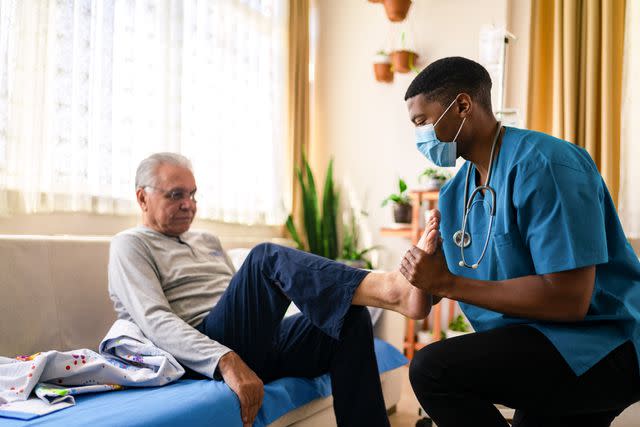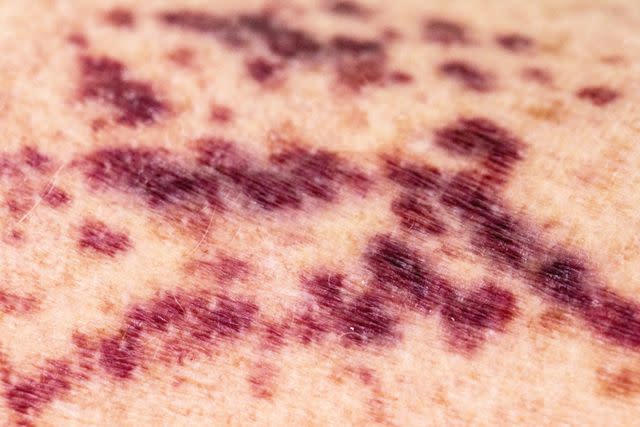What Does a Purpuric Rash Look Like?
Details About Large Bruise-Like Spots on Legs, Ankles, or Thighs
Medically reviewed by Stella Bard, MD
A purpuric rash is an area of the skin covered with purpura. Purpura are bruise-like purple spots on the skin or mucous membranes (such as inside the mouth). Purpuric rashes are a symptom, not a condition.
Most conditions or injuries that cause purpuric rashes are from infections, injury, or autoimmune conditions. The rash can be seen anywhere on the skin but is often found on the legs and arms.
This article will discuss purpuric rash symptoms and causes. It will also cover treatment options and when to see a healthcare provider.

Phynart Studio / Getty Images
Purpuric Rash Symptoms and Characteristics

Jodi Jacobson / Getty Images
Purpuric rash symptoms and characteristics will vary based on the underlying cause. Below is an overview of how purpuric rashes develop.
Location
A purpuric rash can develop anywhere on the skin and mucous membranes. It may be seen on the arms, legs, hands, feet, trunk, and just about anywhere else.
Onset of Symptoms
A purpuric rash will appear when the small blood vessels under the skin leak blood. This onset will vary greatly based on the underlying cause.
Viral infections like chickenpox cause a common type of purpuric rash. This is called an acute thrombocytopenic purpura. It is usually a very sudden onset of symptoms and resolves in a few weeks to six months.
Appearance and Shape

Reproduced with permission from ©DermNet New Zealand and © Raimo Suhonen www.dermnetnz.org 2023.
PurpuraPururpic rashes are made up of purpura spots which range from 4 to 10 millimeters (mm) in diameter. Purpura spots that are smaller than 4 mm are defined as petechiae. When purpura spots grow larger than 1 centimeter (cm) in diameter, they are called ecchymosis (bruises).
Purpura appears red to purple and does not blanch (turn white) when pressed.
A purpuric rash will remain flat against the skin (not raised) and can develop into any shape.
Sensations
A purpuric rash will not itch. It may be tender or slightly painful due to the blood accumulation under the skin. Depending on the underlying illness or injury, there may be other sensations as well.
Causes of Purpuric Rash
Numerous conditions can cause a purpuric rash. Most conditions fall under two categories: non-thrombocytopenic and thrombocytopenic purpura.
"Thrombocytopenic" is a medical term that means "low platelet count." Platelets are a type of blood cell that forms blood clots.
In non-thrombocytopenic purpuric rashes, the person has a normal platelet count. Examples of conditions or circumstances that cause a non-thrombocytopenic purpuric rash are:
Senile purpura
Medications that change platelet function
Scurvy
Henoch-Schönlein purpura
Congenital rubella syndrome
Blood-clotting conditions
Injuries
Thrombocytopenic purpuric rashes occur when someone has a condition that causes a low platelet count. Examples of conditions or circumstances that cause thrombocytopenic purpuric rashes are:
Medications that cause low platelets
Idiopathic thrombocytopenic purpura (ITP)
Other, more rare causes of purpuric rashes, are blood cancers like lymphoma and leukemia. These conditions can make abnormal antibodies against platelet proteins.
Diagnosis: How to Tell You Have a Purpuric Rash
A purpuric rash will be primarily diagnosed based on its appearance and the person's health history.
A healthcare provider will then work to determine the underlying cause of the rash. They may use blood tests like a complete blood count (CBC) to evaluate blood cell levels, including platelet counts.
If an infection is suspected, specific testing may be used to make that diagnosis. For example, if meningococcemia is suspected, a healthcare provider will perform a lumbar puncture (spinal tap) to collect cerebrospinal fluid (CSF) for testing.
Treatment, Management, and Self-Care
Treatment options for purpuric rashes are based on the underlying cause.
For thrombocytopenic purpuric rashes, the first two treatments used are:
Steroids: Minimizes platelet destruction and can increase platelet counts within two to three weeks. Potential side effects include irritability, acne, stomach pain, and weight gain.
Intravenous gamma globulin (IVGG): Contains antibodies that slow the destruction of platelets. IVGG produces results within 24 to 48 hours.
If the above treatments do not work, other treatment options include:
Rh immune globulin: Stops the spleen from destroying platelets.
Platelet transfusion: A blood transfusion of platelets to increase platelet levels.
Rituximab: A medication that slows the antiplatelet antibody production.
Splenectomy: Surgical spleen removal.
Non-thrombocytopenic purpuric rashes are treated by relieving the underlying cause.
Senile purpura typically does not need treatment. Those with it might use extra sun protection (sunscreen or long sleeves) to protect their skin.
Amyloidosis treatment varies, but can include chemotherapy, a bone marrow transplant, or medications.
Medications that are causing purpuric rashes may be changed or stopped at the recommendation of a healthcare provider. If the rash spots are aesthetically concerning, they may be covered up with clothes or makeup.
Purpuric Rash Relapse
Underlying illness or injury is typically the cause of a purpuric rash. The rash generally heals and resolves when the cause is treated. However, about 1 out of 3 people with Henoch-Schönlein purpura will have recurrent episodes. They tend to be less severe but last longer.
When to Consult a Healthcare Provider
When someone has a purpuric rash, they should contact their healthcare provider. The rash is a symptom of an underlying cause. The cause can be something mild like senile purpura or a serious health condition like meningococcemia. Whatever the cause, it's best to have it evaluated by a healthcare provider.
Other symptoms can accompany a purpuric rash. Anytime the rash is associated with the following symptoms, seek immediate medical care:
Headache
Nausea and vomiting
Eyes are sensitive to light
Confusion
Bleeding that does not stop
Summary
A purpuric rash is a symptom of an underlying condition or cause. It is characterized by small, red, or purple bruise-like spots on the skin. They can appear almost anywhere and are often found on the arms and legs.
A purpuric rash can be a symptom of a mild condition like senile purpura, or more serious illnesses can cause it. Always have purpuric rashes evaluated and treated by a healthcare provider.
Read the original article on Verywell Health.

